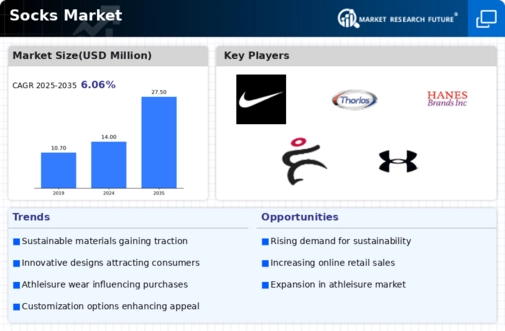Market Growth Projections
The Global Socks Market Industry is poised for substantial growth, with projections indicating a market size of 14.0 USD Billion in 2024 and an anticipated increase to 27.5 USD Billion by 2035. This growth trajectory suggests a robust demand for socks across various segments, driven by factors such as changing consumer preferences, technological advancements, and the rise of e-commerce. The market is likely to experience a compound annual growth rate of 6.36% from 2025 to 2035, reflecting the dynamic nature of consumer behavior and the industry's ability to adapt to emerging trends.
Fashion Trends and Customization
The influence of fashion trends and customization plays a pivotal role in shaping the Global Socks Market Industry. As socks transition from mere functional items to fashion statements, consumers are increasingly drawn to unique designs, patterns, and colors. This trend is particularly pronounced among younger demographics who seek personalized products that reflect their individual style. Brands that offer customizable options or collaborate with designers may capture a larger market share. The growing emphasis on self-expression through fashion is likely to drive demand, contributing to the projected market growth to 27.5 USD Billion by 2035.
Growth of E-commerce and Online Retail
The expansion of e-commerce platforms significantly influences the Global Socks Market Industry. With the increasing penetration of the internet and mobile devices, consumers are more inclined to purchase socks online. This shift is supported by the convenience of online shopping, coupled with a wider variety of options available to consumers. In 2024, the market is expected to benefit from this trend, as online sales channels continue to grow. Retailers that optimize their online presence and offer personalized shopping experiences may see enhanced customer engagement and loyalty, further propelling market growth.
Sustainability and Eco-friendly Products
Sustainability emerges as a critical driver within the Global Socks Market Industry. Consumers are increasingly aware of environmental issues and are seeking eco-friendly sock options made from organic or recycled materials. This shift towards sustainable products is prompting brands to innovate and adopt greener manufacturing processes. As a result, the market is likely to witness a rise in the availability of sustainable sock lines, appealing to environmentally conscious consumers. This trend not only enhances brand reputation but also aligns with the growing demand for responsible consumption, potentially contributing to the market's growth trajectory.
Rising Demand for Comfort and Functionality
The Global Socks Market Industry experiences a notable increase in demand for comfort and functionality. Consumers are increasingly prioritizing socks that offer enhanced comfort, moisture-wicking properties, and support for various activities. This trend is particularly evident in the athletic and outdoor segments, where performance socks are gaining traction. As a result, the market is projected to reach 14.0 USD Billion in 2024, driven by innovations in fabric technology and design. Brands that focus on ergonomic features and breathable materials are likely to capture a larger share of the market, appealing to health-conscious consumers seeking both style and performance.
Technological Advancements in Manufacturing
Technological advancements in manufacturing processes significantly impact the Global Socks Market Industry. Innovations such as seamless knitting technology and automated production lines enhance efficiency and product quality. These advancements allow manufacturers to produce high-performance socks with improved durability and comfort. As the industry embraces these technologies, it is expected to streamline operations and reduce costs, ultimately benefiting consumers through better products at competitive prices. The ongoing evolution in manufacturing techniques may play a crucial role in sustaining the market's growth, particularly as it approaches a CAGR of 6.36% from 2025 to 2035.






